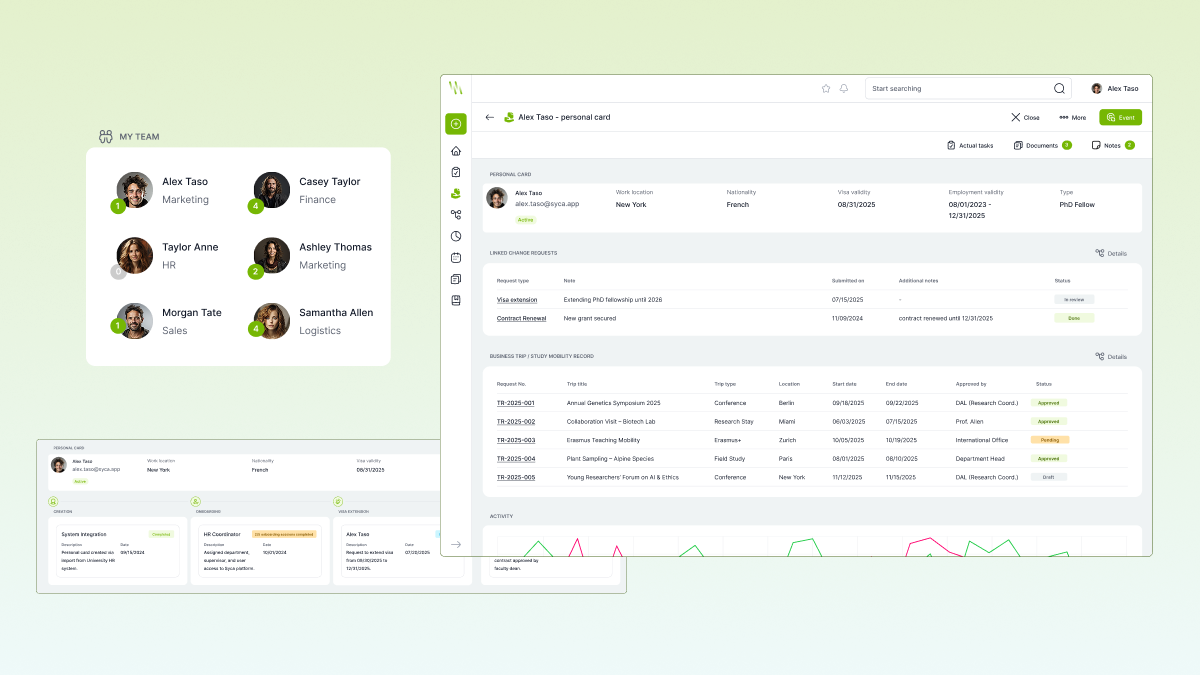
Modern Student Management for International Mobility
Streamline foreign student management with a single source of truth, clear mobility tracking, and faster approvals.

Managing foreign students, interns, and PhD fellows is no small task. Between visa regulations, contract timelines, and mobility tracking, administrators often find themselves juggling multiple systems, endless email chains, and manual data entry. In many universities and research institutions, this complexity is not just inconvenient. It creates the risk of delays, compliance issues, and lost opportunities for both the student and the organization. A structured, integrated student management process can completely change this dynamic and bring order where there was once administrative chaos.
Every student, intern, or research fellow begins their journey with a personal card, which acts as a central record containing all essential information in one place. This includes personal details, affiliation with a department or supervisor, visa validity, and employment or scholarship dates, as well as their current status. When all this information is maintained in a single, up-to-date record, everyone involved — from HR to the international office and faculty supervisors — works with the same accurate data. This eliminates duplication, reduces errors, and improves collaboration between departments, ensuring that no crucial information is ever missed or outdated.
Academic mobility is far more than just travel. It is a structured process that must be documented carefully for funding purposes, compliance obligations, and institutional reporting. Treating each study visit, conference, or research trip as a business trip allows institutions to capture the purpose of the journey, its location, relevant dates, linked requests such as travel or accommodation, and the full approval history. This approach ensures transparency and speeds up the approval process, while giving management a complete and easily accessible history of every individual’s mobility during their time at the institution.
A well-managed student profile follows a clear lifecycle. It begins with the creation of the record, either through a manual entry or by importing it from an existing HR or student information system, and assigning it a unique identifier. The next stage is enrichment, where visa, contract, and departmental details are added and validated. Once active, the record is used in workflows such as trip submissions, change requests, and linked procurement or service orders. The lifecycle concludes with closure, when the record is archived along with its full audit trail after the student’s studies or contract period ends. This structure makes it simple to trace every decision and update across the entire student journey.
A student record is not static and will often need to evolve over time. It may start with onboarding details and role assignments but can later include requests for visa extensions, contract renewals, or profile updates such as changes in contact information or departmental assignment. Eventually, the record also supports end-of-study processing. By keeping all of these updates and requests tied directly to the main student profile, the institution ensures that no information is lost and that approvals always happen within the right context.
This structured approach to student management creates a single, authoritative record for each individual, reducing duplication and errors while ensuring that processes move forward quickly. Approvals for mobility or contract-related changes are no longer stalled by missing information, and compliance with immigration and funding requirements becomes far easier to maintain. The result is a transparent, efficient, and student-friendly system that serves the needs of both the institution and the people it supports.
Explore more
Ready to streamline your processes?
See how Syca’s low-code BPM platform, powered by AI, can help your team work smarter, faster, and without bottlenecks.